

საზოგადოებრივი ამაძონები - მეომარი კოლხი ქალები? 2019, 29 ნოემბერი, 16:38 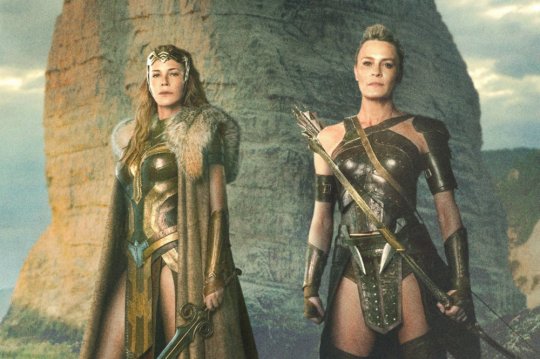
"ოჰ, პრომეთე, შენი ტანჯვის გამო ტირიან ამორძალები, რომელთა ცხენთა ფლოქვები თქერავენ კოლხეთის ველებს. იგლოვენ ჩრდილოეთის ტრამალებში მცხოვრები ველური სკვითები. გმინავენ არიელები, არესის ძენი, კავკასიის კლდეთა ნაკვეთი ქალაქიდან მათი შუბების ჟღრიალი ისმის." კონსტანტინე გამსახურდია. 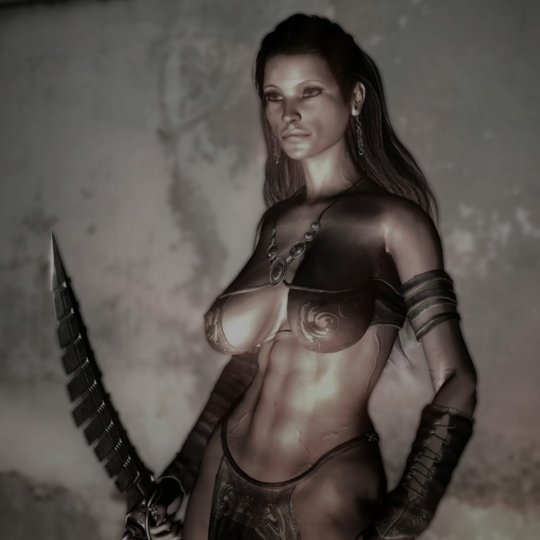
ამაძონები იყვნენ ღმერთ არესისა და ნიმფა ჰარმონიას ასულნი, მითური, მეომარ დამპყრობელ ქალთა მოდგმა, რომელიც მძლავ სამხედრო სამეფოს შეადგენდა. მათი სამეფოს მდებარეობის რამდენიმე ვარიანტია განხილული: მეოტიდის ტბის (აზოვის ზღვის) სანაპიროებზე, სკვითიაში, პონტიდაში (ჰომეროსის მიხედვით), თრაკიაში, ტრიტონის ტბის მიდამოებში, ლიბიაში (დიოდ.) - აფრიკაში, ან ყველაზე უფრო სავარაუდოდ მცირე აზიაში. ამ საკითხზე აზრთა სხვადასხვაობის მიუხედავად, ერთი რამ უფრო დადგენილია: დოიანტის ველზე სამი ქალაქი ჰქონდათ, მეომარ ქალთა სამეფოს ცენტრი კი იყო თემისკირა - ქალაქი მდინარე თერმოდონტზე, კაპადოკიაში. სძაგდათ მამაკაცები, თავიანთ ქვეყანაში არ აჩერებდნენ. შთამომავლობის გასაგრძელებლად, გარკვეული დროით იწვევდნენ ხოლმე მეზობელი ქვეყნის მამაკაცებს, შეუღლების შემდეგ უკანვე უშვებდნენ. 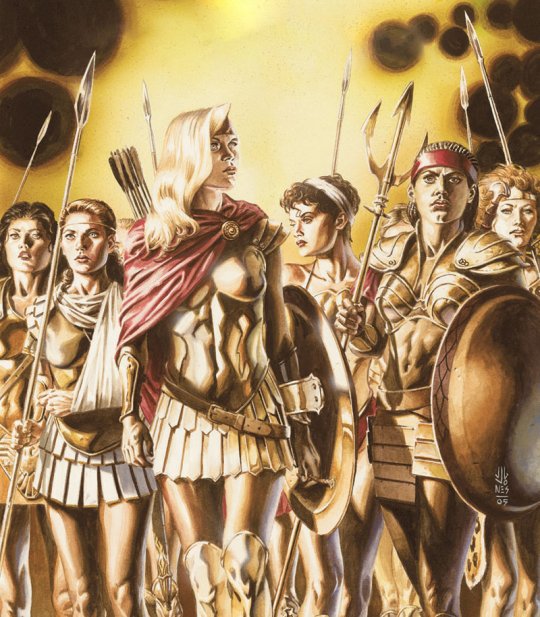
ახალშობილ ვაჟებს მამებს უგზავნიდნენ (ან ხოცავდნენ, რაც ნაკლებად დასტურდება). გოგონებს კი იტოვებდენ და ზრდიდნენ მამაც მეომრებად, რომელნიც ბერძენთა უპირველეს გმირებთან შებმასაც კი არ გაურბოდნენ. ყმაწვილქალობაშივე ამოწვავდნენ მარჯვენა ძუძუს ან ორივეს, რათა უფრო თავისუფლად ეხმარათ მშვილდი, ორპირი ნაჯახი, ხელშუბი, ნახევარმთვარის მოყვანილობის ფარი, სამკერდე ღვედით დაკიდული ხმალი და სხვა იარაღი. 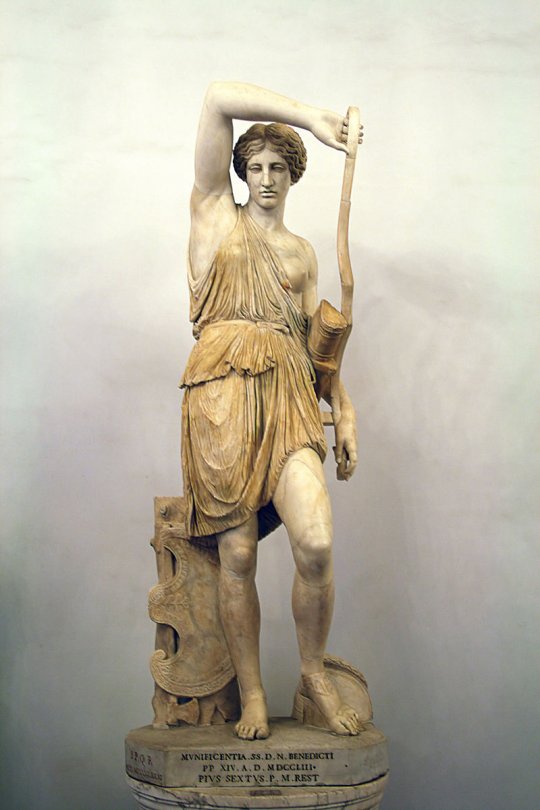
მრავალი ავტორი ამით ხსნიდა თვით ტომის სახელწოდებას: ამაძონი (a-maZos) ბერძნულად უმკერდოს, უძუძუოს ეწოდება. მაგრამ ეს ეტიმოლოგია საეჭვოა და არც დასტურდება ხელოვნებაში: თითქმის ყველა ბერძნულ ქანდაკებასა და გამოსახულებაში ამაძონები გამოისახებიან მშვენიერ, სისხლსავსე, ახალგაზრდა შეიარაღებულ ქალებად. მოკლე, მხედრული სამოსი აცვიათ, მკერდი უჩანთ და დასახიჩრების არავითარი კვალი არ ამჩნევიათ (თუმცა შესაძლებელია ისიც, რომ ხელოვანს ეს დასახიჩრება არ ეჩვენებინა). 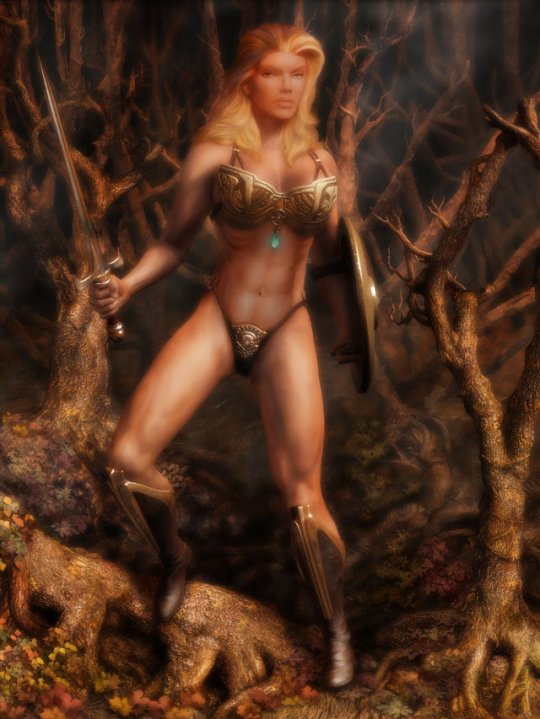
ამაძონთა გამოჩენა თავზარს სცემდა მცირე აზიის ხალხებსა და თვით საბერძნეთს, თუმცა ფეზევსმა სძლია მათ ატიკაში. აქაველმა გმირებმა ტროის კედლებთან და ჰერაკლემაც მანამ, სანამ ჰიპოლიტეს სარტყელი გაიტაცებდა. ამაძონები შეუპოვარი მეომრები იყვნენ, უყვარდათ ლაშქრობა, ანგრევდნენ ქალაქებს, მაგრამ ააშენეს კიდეც სმირნა, ეფესო, მირინა და სხვა ქალაქები. თაყვანს სცემდნენ არესსა და არტემიდეს. მითი მათ არესის ასულებად თვლის. 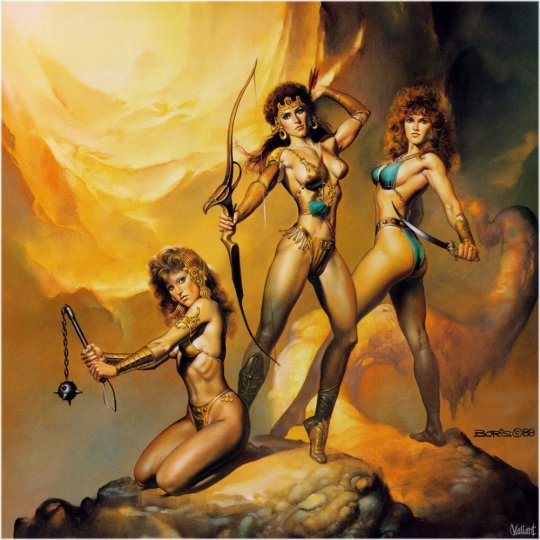
ფიქრობენ, რომ ოდესღაც მართლაც არსებობდა მეომარ ქალთა სახელმწიფო. ასევე არსებობს ვარაუდი, რომ ესაა ბერძნულზე ადრინდელი წარმართული ღვთაება სახელად "მას", ან "მა-დივია". მცირე აზიურ ღმერთთა დიდი დედის გამოძახილი. ან უკავშირდება მითს ეფესოელ არტემიდეს ქურუმ ქალებზე, რომელთაც აგრეთვე მრავალი ქალაქი დააარსეს. ზოგი მითურად თვლის, ზოგი ისტორიულ დასაბუთებას ეძებს, ზოგი თმამოშვებულ მამაკაცებად მიიჩნევს, ზოგი ძველ კოლხ ქალთა ტომად მოიხსენიებს, რაც სილამაზის, თავისუფლებისა და მეომრული სულისკვეთების თვალსაზრისით, ბევრ საგულისხმო შეხვედრას გვაძლევს. თვით მითი მეტყველებს: მეზობელი ხალხი, რომელსაც ამაძონები შეუღლებისას იწვევდნენ მდნარე კავკასოსის ნაპირებზე მოსახლე გარგარეველთა ტომი იყო. ქართულია ერთადერთი ენა, რომელზეც ამაძონებს სხვა სახელი აქვთ: ამორძალები. სტრაბონი (ძვ.წ. 64 - ახ.წ. 24) პირდაპირ წერს: "ამაძონები უმეტესწილად კავკასიელ მამაკაცებს, კოლხებს იწვევდნენ, რაც მათი მოდგმის წარმომავლობაზე პირდაპირ მეტყველებს. 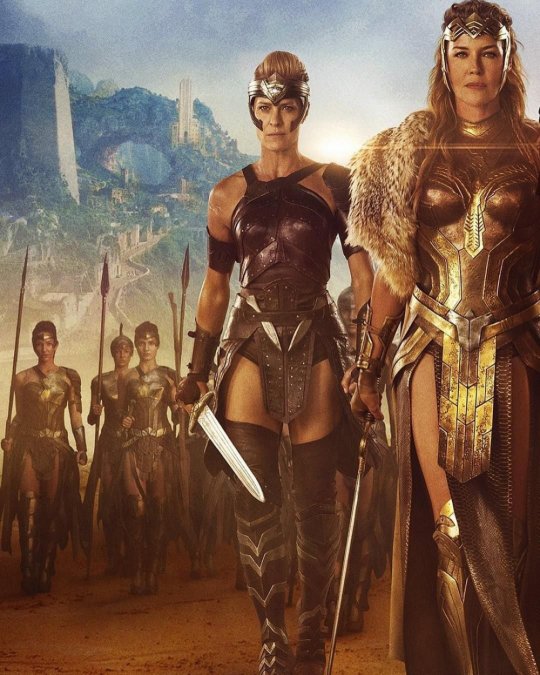
მრავალ ძველ ხალხში არსებობდა წარჩინებულ ქალთა შთამომავლობითი ხაზი (კელტებში, ეგვიპტელებში), რაც აგრეთვე გასაქანს აძლევდა მითების შემქმნელთა ფანტაზიას: გვარი გრძელდებოდა ქალთა და მამაკაცთა ხაზით. ეს მატრიარქალური ეპოქის გამოძახილი უნდა იყოს. მითის ძირებს ისევ წინარებერძნულ სამყაროში მივყავართ. ამ თვალსაზრისს ამართლებს მეომარ ქალთა შემოსილობაც ხელოვნების ძეგლებში. ან მოკლე ბერძნული ქიტონები აცვიათ, ან აზიური, სახელოებიანი ვიწრო სამოსი, შარვლები, ფრიგიული ქუდი ახურავთ. 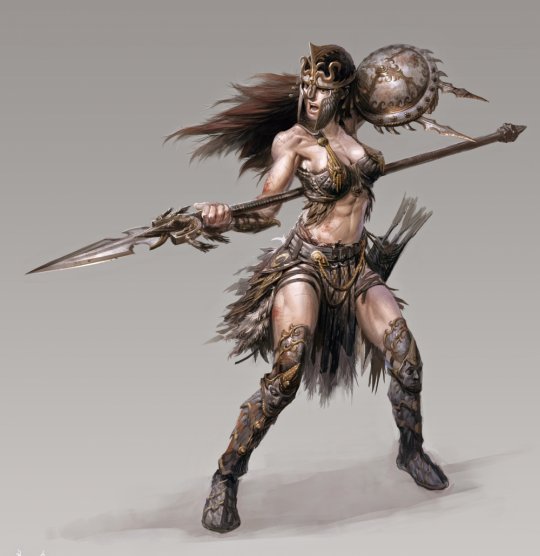
ამაძონთა იარაღია მშვილდ-ისარი, შუბი, ხმალი, ორპირი ნაჯახი, ნახევარმთვარის მოყვანილობის ფარი. ასეთი მეომარი ქალები მრავალ ხალხს ჰყოლია. ცნობილ ჩეხურ თქმულებაში ვრცლადაა მოთხრობილი ვიშეგრადსკელი ამაძონების ამბოხებაზე. მითის გენეზისის საკითხი მაინც პრობლემად რჩება. სამაგიეროდ, ნათელია ამ საოცარ ქალთა მომხიბლავი პოეტური სამყარო. მათ სახელთანაა დაკავშირებული მრავალი ბერძნული თქმულება: ჰერაკლემ ილაშქრა, მოიპოვა დედოფალ ჰიპოლიტეს სარტყელი და ეს იყო მისი მეცხრე გმირობა. თეზევსმა, ათენის მეფე-გმირმა შებმა შეუბედა და მოიტაცა ამაძონთა დედოფალი ანტიოპე თუ ჰიპოლიტე. შემდეგ ცოლად შეირთო და შეეთვისა. მერე კი დაამარცხა ქალის დასაბრუნებლად ატიკაში შეჭრილი ამაძონები. მამაცი და მოუსვენარი ქალები ისედაც არაერთხელ შებმიან ბერძნებს. უწინ, ფრიგიაში ახალგაზრდა პრიამოსი ამაძონებს ეომებოდა, რაც მოთხრობილია "ილიადაში" (3, 189). შემდეგ კი ამაძონები პრიამოსს ეხმარებოდნენ ტროას ომში. იმ ომში აქილევსმა მოკლა ამაძონთა დედოფალი ჰენთესილეა (ნ. თერსიტე). 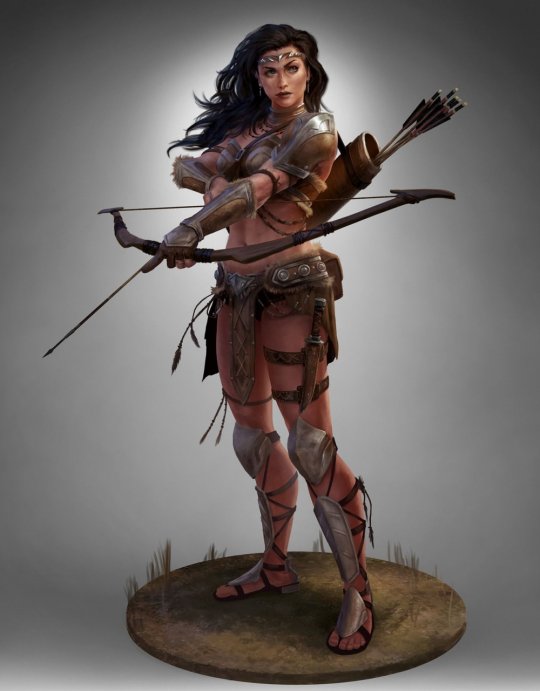
ამაძონთა სამეფოდ რომ სხვადასხვა მხარეს აცხადებენ, ეს უფრო იმ შორეულ მხარეთა სახელებია, სადაც მათ ილაშქრეს, ესენია: სკვითია, თრაკია, ტროა, ათენი, სირია, მცირე აზიის სხვადასხვა მხარე. როცა ლიკიაში მეფე იობატეს დაესხნენ თავს, ბელეროფონტმა მათი ლაშქარი გაანადგურა (ილ. 6, 196); აპ. როდ. არგ. 2, 374, 386, 912, 965... 1173; აპოლოდ. 2, 3, 2; 2, 5, 9; ეპ. 1, 16-17. 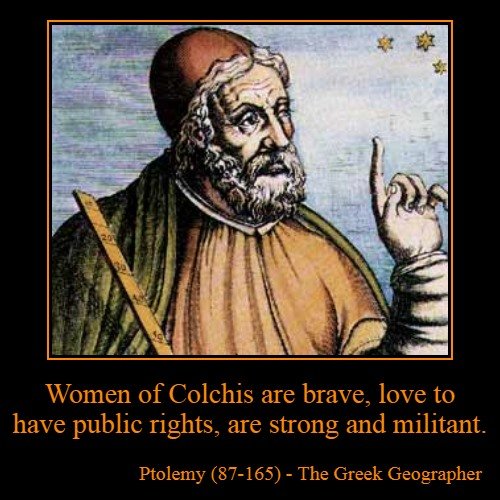
საინტერესოა ასევე თუ რას წერენ ძველი ბერძენი სწავლულები კოლხეთის ქალებზე. მაგალითად პტოლემე (87-165), ბერძენი სწავლული, მათემატიკოსი, გეოგრაფი და ასტრონომი წერდა: "კოლხეთში ქალები არიან მამაცნი, უფლების მოყვარენი, ძლიერნი და მებრძოლნი." ხოლო ძველბერძენი პოეტი, ტრაგიკოსი ესქილე (ძვ.წ. 525-456) წერდა: "კოლხიდის გმირები, ყმაწვილი ქალები, ომში მამაცები, უშიშრად არიან". ასეთი უამრავი მაგალითია ბერძნულ ისტორიოგრაფიასა თუ მითოლოგიაში, სადაც კოლხ ქალებს მოიხსენიებენ, როგორც მამაკაცებთან ტოლის არდამდებად, თანასწორებად, მეომრებად. 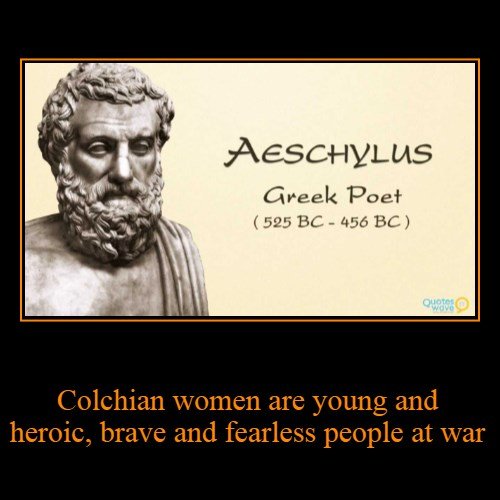
ხელოვნებაში ამაძონთა სახეებს მუდამ თვალსაჩინო ადგილი უჭირავს. უწინარეს ყოვლისა, ასახელებენ ფიდიასის "დაჭრილ ამაძონს" (ძვ.წ. მე-5 საუკუნე). იმავე სახელით ყოფილა ცნობილი ეფესოს არტემიდეს ტაძრისთვის პოლიკლეტეს, ფრადმონისა და სხვათა ხელით (პლინიუსი), შექმნილი ქანდაკებანი. ცნობილია კაპიტოლიუმის (პოლიკლეტესეული) თავზე ხელებშემოდებული ვატიკანის ფიდიასისეული და სხვა ქანდაკებანი. ლარნაკებზე გამოსახულ სახეთა შორის უფრო ცნობილია ამაძონთა ბრძოლის - ამაძონომაქიის ნიმუშები ძვ.წ. მე-7 საუკუნიდან. ათენის პართენონის რელიეფი, აპოლონის ტაძრის ფრიზი, ჰალიკარნასის მავზოლეუმის გამოსახულება (ძვ.წ. მე-4 საუკუნე), შესანიშნავი სურათები აქვთ შექმნილი რუბენსს ("ამაძონთა ბრძოლა"), ფოიერბახს, კოკოშკას. ცნობილია ემილ ვოლგის "ამაძონები ბრძოლის შემდეგ" (მარმარილო, გერმანია). 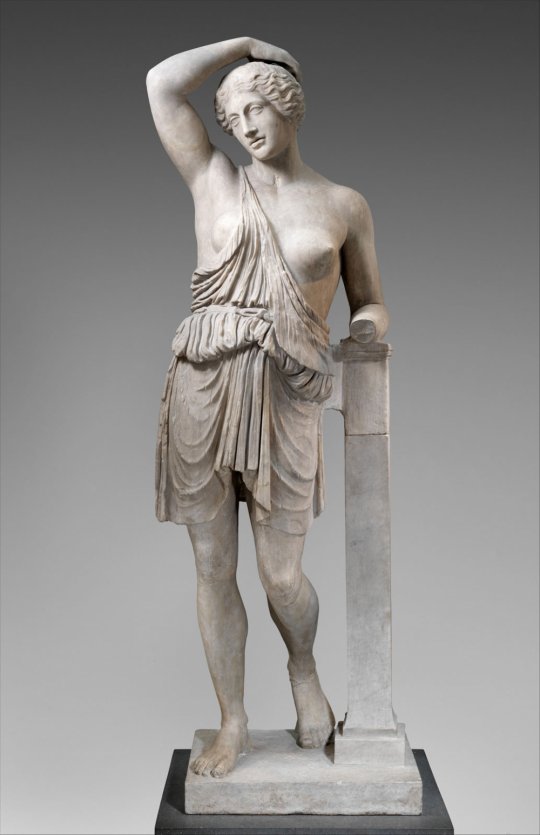
შუა საუკუნეებში ამაძონთა მითური სახე მრავალ პოეტს, მეცნიერსა და აღმომჩენს ხიბლავდა. მათი სახელი ეწოდა ამაზონის მდინარეს და აქედან ამაზონის ტყეების უდიდეს მასივს. ახალაღმოჩენილი სამხრეთ ამერიკის ჯუნგლებში გაშლილ ამ უდიდეს მდინარეს პირველად სხვა სახელები ერქვა. მისი პირველი დიდი მკვლევარის, ორელიანას მტკიცებით, ინდიელი ქალებიც მამაკაცური შეუპოვრობით ებრძოდნენ ესპანელებს, რისთვისაც ესპანელებმა ამ მდინარეს უწოდეს "რიო დე ლას ამაზონას" - ამაძონთა მდინარე, თუმცა იმას უფრო ვარაუდობდნენ, რომ ეს არის ამერიკელი აბორიგენების "ამაზუნუ" (ზღვის დიდი ტალღა). ბერძნები კი ძველად მდინარე ტანაიის ეძახდნენ ამაძონიოსს. ამაძონიოსი ეწოდებოდა ასევე მთებს, სადაც სათავეს იღებდა ამაძონთა მდინარე თერმოდონტი. წყარო: აკაკი გელოვანი. "მითოლოგიური ლექსიკონი". 1983. კრებულები:1. ქართველური ტომები2. ქართული სახელმწიფოები3. კავკასიური კულტურები4. საქართველო5. საქართველო (ნაწ. მეორე)6. ნაციზმი7. ჰიტლერი8. რელიგია9. პარანორმალი10. მეცნიერება11. მეცნიერება (ნაწ. მეორე)12. ქართული მითოლოგიაავტორი: თორნიკე ფხალაძე2445 1-ს მოსწონს |
Constantine Gamsakhurdia. Georgian author, father of the first President of Georgia.
"ოჰ, პრომეთე, შენი ტანჯვის გამო ტირიან ამორძალები, რომელთა ცხენთა ფლოქვები თქერავენ კოლხეთის ველებს, იგლოვენ ჩრდილოეთის ტრამალებში მცხოვრები ველური სკვითები. გმინავენ არიელები, არესის ძენი, კავკასიის კლდეთა ნაკვეთი ქალაქიდან მათი შუბების ჟღრიალი ისმის !.."
კონსტანტინე გამსახურდია.
In this regard, it is very significant that in the Middle Ages there was a queen named Tamar (1184 - 1213) who made Georgia great. She represents the Golden Age of Georgia.
In Greek antiquity Colchis was seen as a distant country and as a rich one because of its gold and knowledge. That is why, the Greek hero Jason was sent to Colchis. His task was to steal the famous Golden Fleece.
When the Greeks came to the region east of the Black Sea in the second half of the 2nd millennium BC, they encountered a well-organized, high-developed people. From the 13th till the 1st century BC there existed the kingdom of Colchis which had a very special culture. The political center was inland at the river Phasis (today Rioni). In the ancient sources there is mentioned the capital Kutaia. It is obvious that this place is identical with today's Georgian city Kutaisi.
In Vani, about 60 km off the Black Sea coast, there was discovered an impressive temple city with richly endowed rock tombs. In these tombs, there were found valuable grave goods of precious metal, mostly gold.
Colchis was very famous for its goldsmith work. Specially on behalf of granulation technique the Colchians were true masters and they were the makers of this technique. So again, the famous Golden Fleece of Colchis alludes to a true background.
In fact, the burial customs reveal an egalitarian social order. Mostly, there were found collective burials - a clear hint to egality.
Very characteristic for Colchis there are figures of riding women. They always sit sideways on the horse, very often they hold a baby in their arms. That riding woman represents the Colchian main goddess "Nana" - a goddess who stands for the belief in rebirth. That is why, pompous individual burials had no meaning for the Colchians because they knew that they were reborn. Life and death were an eternal cycle, so a richly endowed individual burial made no sense. Rebirth belief in Colchians was common since Stone Age and connected with it was the predominating role of the woman because only she is able to bear.
Most of the ancient sources say that the Amazons lived at the river Thermodon in northern Central Anatolia and where the neighbors of another Colchian tribes. Besides this, there is the tradition about Caucasian Amazons. The Greek historian and geographer Strabo (63 BC - 23 AD) is the essential source. He is considered to be very reliable; he traveled a lot and he scrutinized the older sources he used for himself. In the course of his description of the Caucasus he mentions that in the mountains above Albania, Amazons lived. Albania is a region which roughly correlates with East Georgia and the Northern Azerbaijan. In detail he informs that a river named Mermadalis flows through the Amazon land. This river has its source in the Caucasus, then flows through the land of the Amazons. Later on, the river crosses a desert and empties into the Azov Sea.
A concrete localization of this Caucasian Amazon land on the basis of Strabo's description is rather difficult. if you lay the focus on the local hint towards »Albania« this land must have been in the eastern part of the Caucasus mountains, maybe in Tusheti, Pshavi, Khevsureti, Khevi, Ingusheti, Chechnya or Dagestan. On the other hand, if you consider the information that this river Mermadalis empties into the Azov Sea, then only the river Kuban or one of his tributaries come into question. Then this Amazon land must have been in the western part of the Caucasus, that would also mean north of Colchis, where the Georgian tribes Svans and Dvals were living.
The findings show quite clear that in this part of the Caucasus there existed a people - Colchian tribe - Dvals, where obviously men and women lived together as equals. Women also took part in armed conflicts and proudly presented their role as warriors in the graves. Actually, it is not an Amazon people as Strabo had described. In fact, it seems much more similar to the description by Herodotus. According to Herodotus, the Amazons had formed a community with Sauromatian men after their flight from the Thermodon region. In this community they could partially preserve their former way of life at the side of their Sauromatian men. They carried weapons and fought together with their men. in the course of time the »Amazonian« attitude of the women lessened more and more, fewer and fewer women were warriors and took part in armed conflicts. This is the reason why men's graves containing weapons prevail in Tli. Actually, the fact alone that there are women's graves containing weapons is rather striking, and in some respects, it confirms the stories about Amazons which the ancient historians passed on to us.
What was the reason that the Swiss Johann Jakob Bachofen (December 22nd, 1815 - November 25th, 1887), descendant of one of the most distinguished families of Basel ventured to publish a thesis which was most appalling for the 19th century?
It must have been his unbreakable conviction that his theory must be right, otherwise he would not have risked to lose his high reputation and his good name as respectable judge.
He was the first one who held the position that there had been a phase in history of mankind when women were the predominating gender. He named this phase - Mother Right, today we use the term 'Matriarchy' or 'Matriarchate'.
Johann Jakob Bachofen was the first one who fought for the acceptance of the matriarchy as historical fact. Like Don Quixote fighting windmills he struggled his whole life against the contemporary attitude that his theory of the Mother Right was nonsense. A critic of his time called his research 'higher rubbish'. Unfounded criticism, lack of understanding and mockery hurt him very much but it didn't stop him to go his way consequently.
Alexis Giraud-Teulon was one of the few ones who already recognized Bachofen's genius during his lifetime. The Genevan scientist was a great admirer of his »Mother Right«. They much corresponded by letter, and thus Giraud-Teulon picked up many ideas of Bachofen and re-used them for his own research work. The esteem by Giraud-Teulon was a great mental benefit for Bachofen, because most contemporary scientists denied Bachofen's work and didn't take it seriously.
In his book »La Mère chez certains peuples de l'Antiquité« (English: The Mother at certain peoples of antiquity) Giraud-Teulon picked up the idea of the Mother Right, but he transformed it in this way that he didn't see it as a general stage of human development but as a special appearance which can only be traced at certain peoples of antiquity. Actually, his point of view is widely accepted today. He assigned this special social order to pre-Indo-European cultures. So he traced a cluster of matriarchal peoples which spread from Asia Minor across North Africa till Spain and the Canaries, those were the ancient Carians, Lycians, Nubians (=Ethiopians) and Libyans. Concerning the Amazons he disagrees with Bachofen. He thinks that there had never existed Amazon nations. He believes that the Amazon myth has been inspired by matriarchal priestesses who carried weapons and defended their temples against the patriarchal invaders.
Approximately in the center of the Mediterranean Sea, halfway between Sicily and Tunisia, there are the islands Malta and Gozo which are very famous for their mighty prehistoric temples. More than 5000 years ago there had existed a highly-developed civilization on these small Mediterranean islands. Imposing stone monuments give evidence of its former significance and prosperity.
On Malta there are the temples Hal Tarxien, Hagar Qim, Mnajdra and the subterranean temple Hal Saflieni, which impress and make you wonder how Stone Age people could make them; on Gozo there is the huge twin temple Ggantija.
The temples form a unity with their surrounding landscape. It is evident that the ancient people of Malta had very deliberately chosen the places for their temples.
The subterranean temple Hal Saflieni was of special significance. In its elaborately constructed stone rooms there have been discovered the bones of about 7000 people. The walls had been painted red by ochre. There has been found the statue of a goddess in sleeping position (4100–2500 BC). This sleeping goddess represents the aspect of death which in matriarchal religion was directly connected with rebirth. Correspondingly, in Greek mythology the god of sleep, Morpheus, was the brother of the god of death, Thanatos.
Many woman figurines - with very feminine shapes - have been found in the temples. They have to be interpreted as representations of the almighty »Great Mother«. The worship of the »Great Mother« is an essential characteristic of matriarchal cultures - those are civilizations in which women have the predominating gender role.
The impressing prehistoric remains of Malta and Gozo clearly give evidence that about 5000 years ago there had existed a highly-developed, presumably matriarchal civilization.